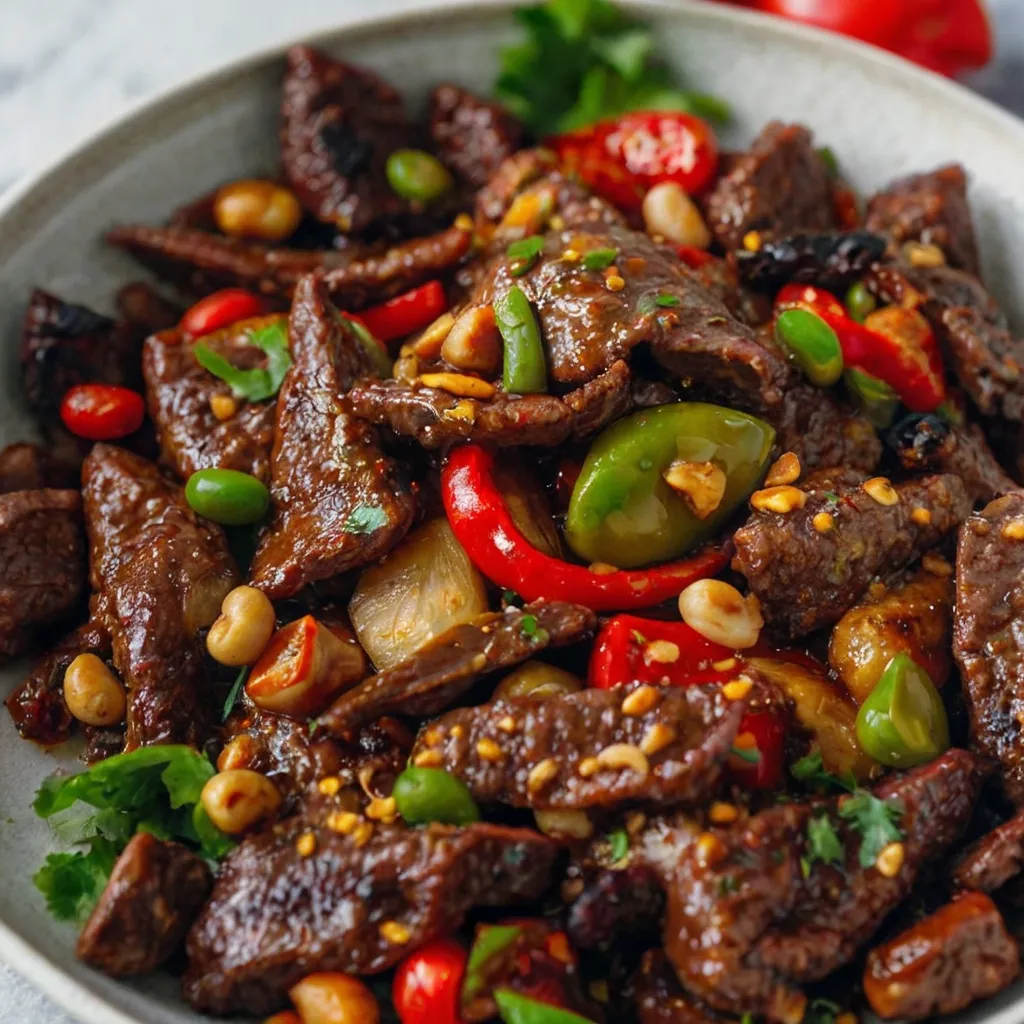The Ultimate Kung Pao Beef Recipe (Better Than Takeout!)
Find the best kung pao beef recipes for a quick, flavorful dinner. Spicy and savory – your taste buds will thank you.
Introduction
There’s something undeniably satisfying about the perfect balance of flavors in a well-made Kung Pao dish. That first bite hits you with the savory-sweet sauce, followed by the subtle heat of dried chilies, the crunch of peanuts, and tender pieces of beef that practically melt in your mouth. For years, I ordered this classic Sichuan dish from my local takeout spot until I finally decided to master Kung Pao Beef at home.
This recipe will give you restaurant-quality Kung Pao Beef in the comfort of your own home, and it’s easier than you think! Whether you’re looking for a quick weeknight dinner, a crowd-pleasing meal, or a healthier option, this recipe has you covered. The beauty of making Kung Pao Beef is that you can control the ingredients, adjust the spice level to your preference, and enjoy it fresh off the wok without waiting for delivery.
Join me as I walk you through making the ultimate Kung Pao Beef that will have you reaching for your chopsticks instead of your phone the next time a Chinese food craving strikes!
Content overview
Table of Contents
Ingredients
For the Beef and Marinade:
- 1½ pounds flank steak or sirloin, thinly sliced against the grain
- 1 tablespoon Shaoxing wine (or dry sherry)
- 1 tablespoon soy sauce
- 1 tablespoon cornstarch
- ½ teaspoon baking soda (for tenderizing)
- 1 teaspoon vegetable oil
For the Sauce:
- 3 tablespoons soy sauce
- 2 tablespoons Chinese black vinegar (or substitute with rice vinegar)
- 2 tablespoons Shaoxing wine (or dry sherry)
- 2 tablespoons brown sugar
- 1 tablespoon cornstarch
- 1 teaspoon sesame oil
- ¼ cup water
Discover more Beef Dishes Recipes
For the Stir-fry:
- 3 tablespoons vegetable oil, divided
- 8-12 dried red chilies (adjust to taste)
- 1 tablespoon Sichuan peppercorns (optional, for authentic flavor)
- 4 cloves garlic, minced
- 1-inch piece ginger, minced
- 4 green onions, white parts and green parts separated, chopped
- 1 red bell pepper, diced
- 1 green bell pepper, diced
- ⅔ cup unsalted roasted peanuts
- Steamed rice, for serving
Note: Can’t find Shaoxing wine? Dry sherry makes an excellent substitute. If you prefer to avoid alcohol, use chicken broth with a splash of rice vinegar instead.
Pro Tip: For harder-to-find ingredients like Chinese black vinegar or Sichuan peppercorns, check your local Asian grocery store or purchase online.
Discover more Beef Dishes Recipes
Step-by-Step Instructions
Step 1: Prepare and Marinate the Beef
- Place the beef in the freezer for 15-20 minutes (not to freeze it, but to make it easier to slice thinly).
- Remove the beef and slice it against the grain into thin strips, about ¼-inch thick and 2 inches long.
- In a medium bowl, combine the sliced beef with Shaoxing wine, soy sauce, cornstarch, baking soda, and vegetable oil.
- Mix well to ensure all pieces are coated, then let marinate for at least 15 minutes (up to 1 hour if you have time).
Pro Tip: The baking soda is the secret to restaurant-style tender beef. It changes the pH of the meat surface, making it difficult for proteins to bond during cooking, which results in more tender meat.
Step 2: Prepare the Sauce
- In a small bowl, whisk together soy sauce, black vinegar, Shaoxing wine, brown sugar, cornstarch, sesame oil, and water until smooth.
- Set aside until needed. The sauce will be added toward the end of cooking.
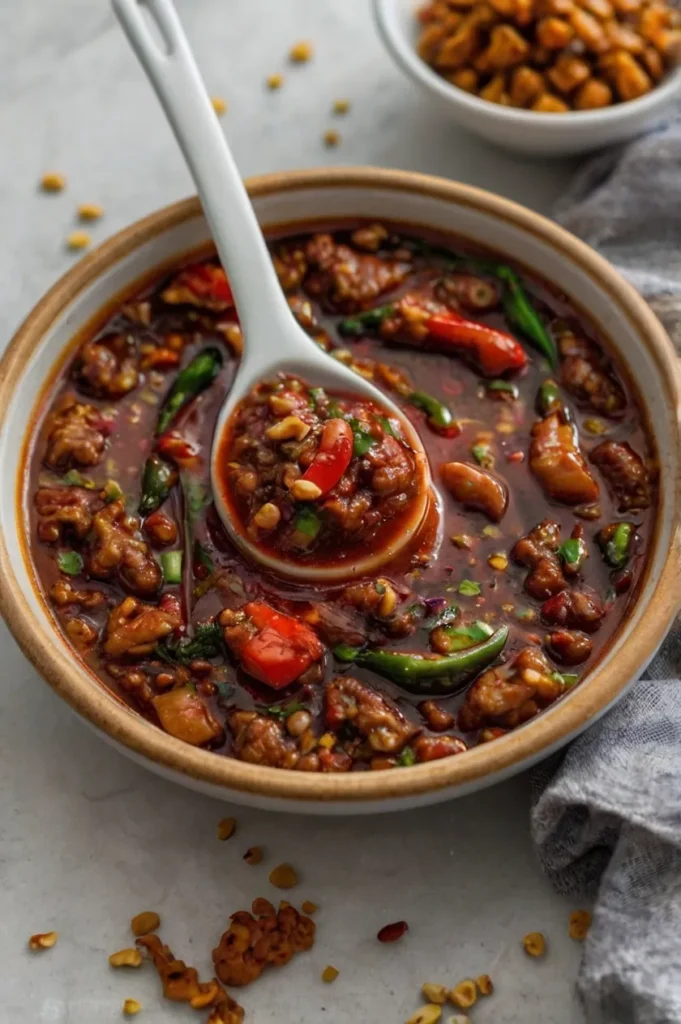
Pro Tip: Mix your sauce before you start cooking the beef. Once you start stir-frying, things move quickly!
Step 3: Prepare Your Vegetables
- While the beef is marinating, prepare all your vegetables.
- Dice bell peppers into roughly 1-inch squares.
- Separate the white and green parts of the green onions, chopping both.
- Mince the garlic and ginger.
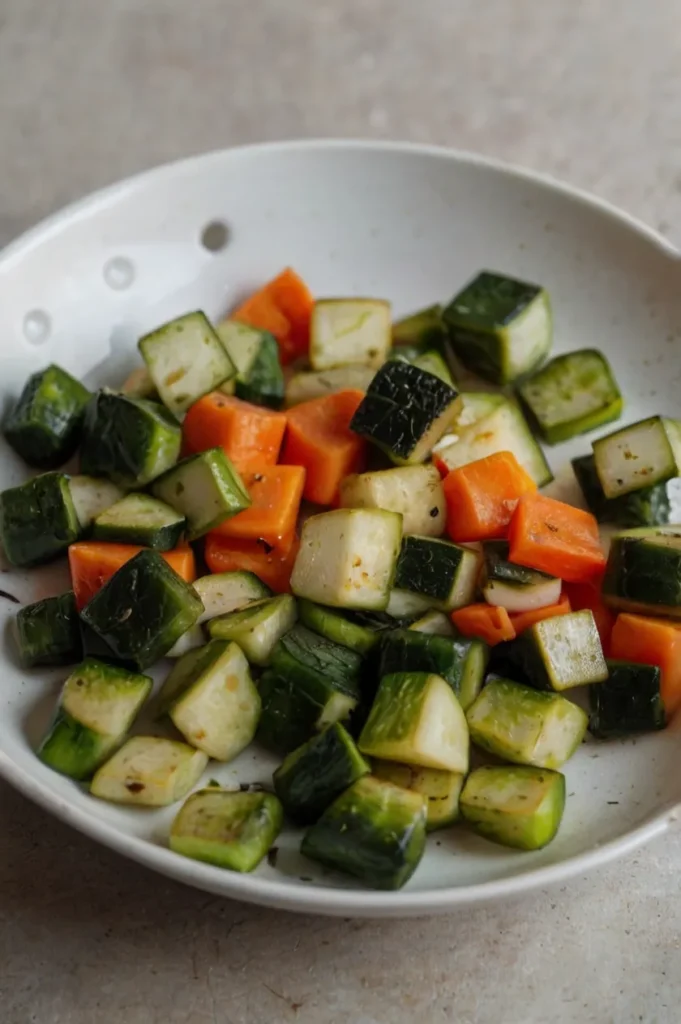
Pro Tip: Having all ingredients prepped and ready to go (mise en place) is crucial for successful stir-frying as the cooking process moves very quickly.
Step 4: Stir-Fry the Aromatics
- Heat a wok or large skillet over high heat until smoking.
- Add 1 tablespoon of vegetable oil, then add dried chilies and Sichuan peppercorns (if using).
- Stir-fry for 30 seconds until fragrant and the chilies begin to darken (be careful not to burn them).
- Add minced garlic, ginger, and white parts of green onions.
- Stir-fry for another 30 seconds until aromatic.
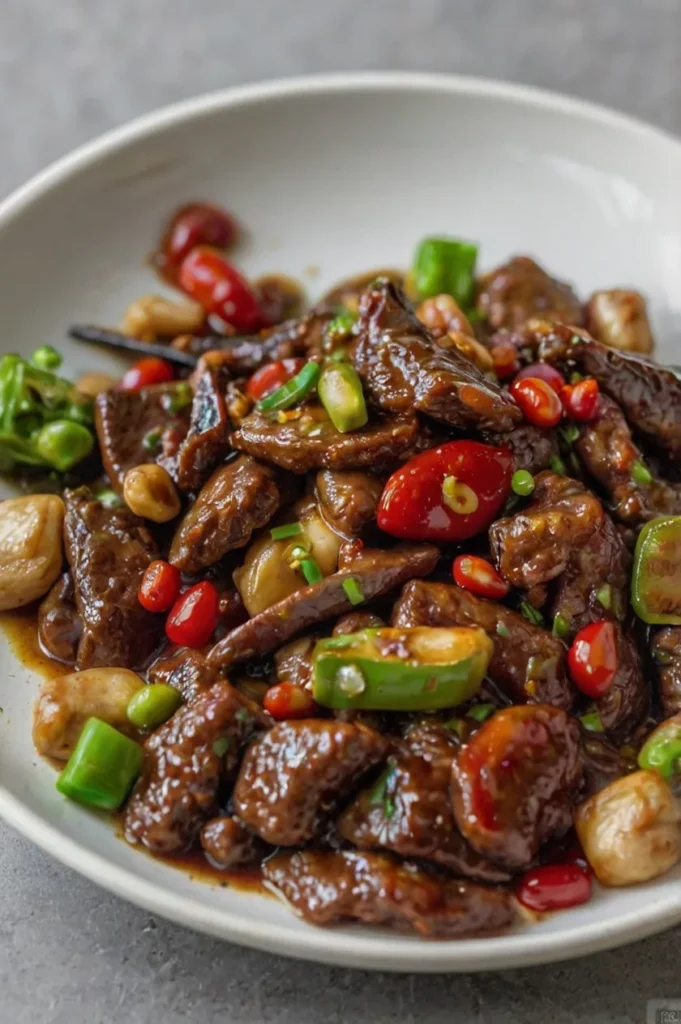
Pro Tip: If you’re sensitive to heat, snip the dried chilies in half and shake out some of the seeds before cooking, or reduce the quantity.
Step 5: Cook the Beef
- Increase heat to high and add another tablespoon of oil to the wok.
- Add the marinated beef, spreading it out in a single layer.
- Let it sear undisturbed for 30 seconds, then stir-fry for 2-3 minutes until the beef is just cooked through.
- Remove the beef from the wok and set aside.
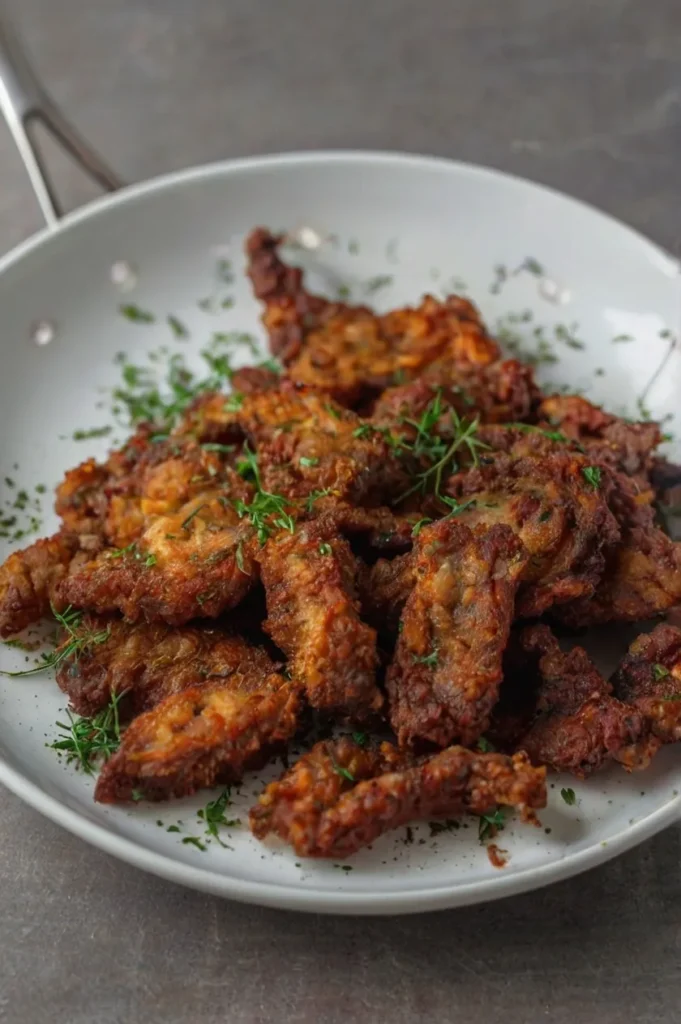
Pro Tip: Don’t overcrowd the pan. If necessary, cook the beef in batches to ensure it sears properly rather than steams.
Step 6: Cook the Vegetables
- Add the remaining tablespoon of oil to the wok.
- Add bell peppers and stir-fry for 1-2 minutes until slightly softened but still crisp.
Discover more Beef Dishes Recipes
Step 7: Combine Everything
- Return the beef to the wok with the peppers.
- Give your sauce mixture a quick stir (the cornstarch will have settled), then pour it into the wok.
- Stir continuously as the sauce thickens, about 30 seconds to 1 minute.
- Add the peanuts and toss everything together to coat evenly.
- Sprinkle with the green parts of the green onions and give everything a final toss.
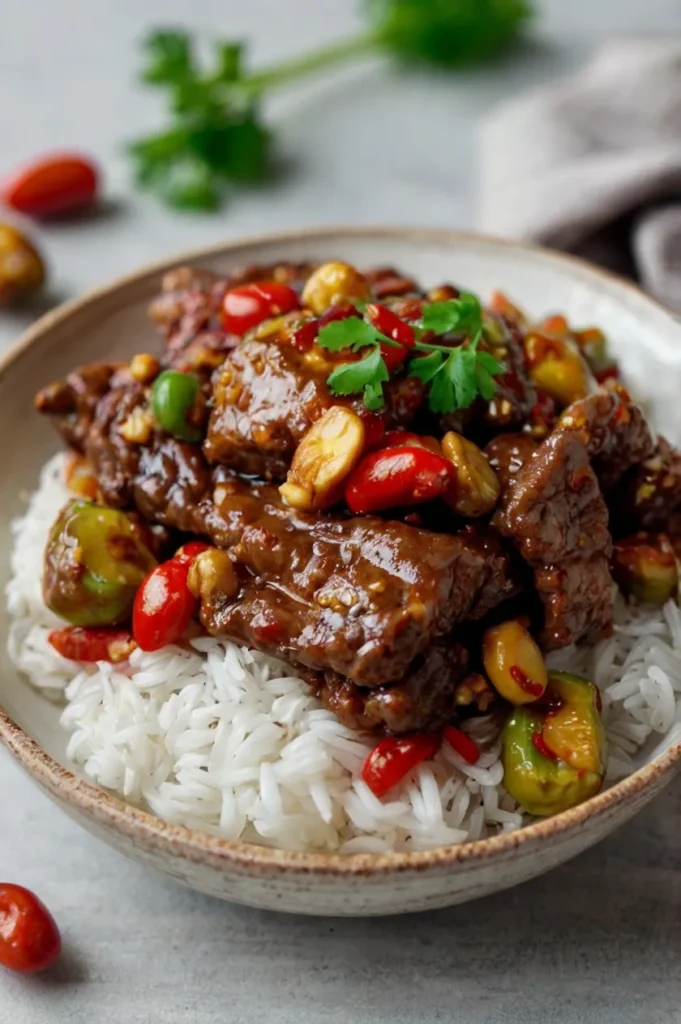
Pro Tip: The sauce thickens quickly, so have everything ready to go before you add it to the wok.
Step 8: Serve
- Transfer your Kung Pao Beef to a serving dish.
- Serve immediately with steamed rice.
Tips & Tricks
For the Perfect Kung Pao Beef:
- Beef Selection: Choose a tender cut like flank steak, sirloin, or ribeye for the best results.
- Cutting Technique: Always slice beef against the grain for maximum tenderness.
- Wok Temperature: Make sure your wok or pan is very hot before adding ingredients. A properly heated wok prevents sticking and ensures quick cooking.
- Don’t Rush: The marinade is crucial for flavor and tenderizing. Give it at least 15 minutes to work its magic.
- Balance of Flavors: The perfect Kung Pao Beef balances sweet, salty, sour, and spicy elements. Taste your sauce before adding it to the wok and adjust as needed.
- Mise en Place: Have everything prepared and within reach before you start cooking. Once you begin stir-frying, the process moves quickly.
Common Mistakes to Avoid:
- Overcrowding the Pan: This causes the beef to steam rather than sear, resulting in tough meat.
- Overcooking the Beef: Stir-fry the beef just until it’s cooked through to keep it tender.
- Burning the Aromatics: The dried chilies and Sichuan peppercorns can burn quickly if not watched carefully.
- Adding Cold Sauce to the Hot Wok: This can lower the temperature too much. Make sure your sauce is at room temperature.
Recipe Variations
Kung Pao Chicken Variation
Simply substitute 1½ pounds of boneless, skinless chicken breasts or thighs (cut into 1-inch cubes) for the beef. The marinade and cooking process remains the same, though chicken may cook slightly faster than beef, so adjust the cooking time accordingly.
Low Carb/Keto Kung Pao Beef
- Replace the sugar with a keto-friendly sweetener like erythritol or monk fruit.
- Substitute cornstarch with xanthan gum (use about ¼ teaspoon for the sauce and skip it in the marinade).
- Serve over cauliflower rice instead of regular rice.
Kung Pao Beef without Peanuts
For those with peanut allergies, substitute roasted cashews or simply omit the nuts altogether. The dish will still be delicious!
Vegan Kung Pao with Tofu
- Replace beef with 14 oz extra-firm tofu, pressed and cut into 1-inch cubes.
- Skip the meat marinade, but toss the tofu cubes in 1 tablespoon cornstarch before frying.
- Fry the tofu first until golden and crispy, then remove and add back in step 7.
Serving Suggestions
Perfect Pairings for Kung Pao Beef:
- Classic: Steamed white rice or brown rice
- Noodles: Lo mein noodles or chow mein
- Vegetables: Steamed broccoli, bok choy, or Chinese green beans
- Soup: Hot and sour soup or egg drop soup as a starter
- Appetizers: Spring rolls or crab rangoon
Garnishing Ideas:
- Extra crushed peanuts
- Thinly sliced green onions
- Sesame seeds
- Crispy wonton strips
- Fresh cilantro leaves
Discover more Beef Dishes Recipes
Nutritional Information
Per Serving (serves 4):
- Calories: 520
- Protein: 35g
- Carbohydrates: 18g
- Fat: 30g
- Fiber: 4g
- Sugar: 8g
- Sodium: 850mg
Note: Nutritional values are approximate and don’t include rice or additional side dishes.
Frequently Asked Questions
Q: Can I freeze Kung Pao Beef? A: Yes, you can freeze cooked Kung Pao Beef for up to 3 months. Store it in an airtight container, but be aware that the vegetables may lose some of their texture when reheated. For best results, freeze just the beef in sauce and prepare fresh vegetables when reheating.
Q: How spicy is this recipe? A: With the recommended amount of dried chilies, this recipe has a moderate heat level. You can easily adjust the spiciness by increasing or decreasing the number of dried chilies. For a milder version, remove the seeds from the chilies or substitute with milder peppers like Anaheim.
Q: Can I make this ahead of time? A: You can prepare all the components (marinate the beef, chop vegetables, mix sauce) up to a day in advance. Store everything separately in the refrigerator. The actual stir-frying should be done just before serving for the best texture and flavor.
Q: What if I don’t have a wok? A: A large skillet or frying pan works well too. The key is to use a pan that can handle high heat and has enough surface area for stir-frying without overcrowding.
Q: Is Kung Pao Beef gluten-free? A: Not as written, but it can easily be made gluten-free by using tamari instead of soy sauce and ensuring your other ingredients (like vinegar) are certified gluten-free.
The History of Kung Pao Beef
Kung Pao dishes originated in the Sichuan province of China and are named after a late Qing Dynasty official, Ding Baozhen, who served as governor of Sichuan. The title “Gong Bao” (宫保) or “Kung Pao” as we know it, was his official title meaning “Palace Guardian.”
Traditionally, the dish was made with chicken, but beef variations have become popular, especially in Western countries. The authentic Sichuan version relies heavily on the numbing sensation provided by Sichuan peppercorns combined with the heat of dried chilies, creating the famous “ma la” (numbing and spicy) flavor profile that Sichuan cuisine is known for.
The American version of Kung Pao typically reduces the heat level and sometimes omits the Sichuan peppercorns entirely, focusing more on the sweet and savory balance. Our recipe seeks a middle ground, honoring the traditional flavors while remaining accessible to home cooks.
Conclusion
Making Kung Pao Beef at home is not only achievable but can actually surpass what you’d get from takeout. With the right ingredients and techniques, you’ll create a dish with perfectly tender beef, crisp vegetables, and that signature spicy-sweet-savory sauce that makes Kung Pao so addictive.
The beauty of mastering this recipe is that once you understand the fundamentals, you can easily adapt it to suit your taste preferences or what you have on hand. Whether you’re craving the classic beef version, want to try it with chicken or tofu, or need to adjust the spice level for your family, this versatile recipe has you covered.
So next time you’re tempted to order takeout, give this homemade Kung Pao Beef a try instead. Your taste buds—and your wallet—will thank you!
Let’s Connect!
Did you try this Kung Pao Beef recipe? I’d love to hear how it turned out! Leave a comment below and rate the recipe to let me know your thoughts.
Don’t forget to share your creations on social media and tag us with #UltimateKungPaoBeef for a chance to be featured on our page!
Happy cooking!
Let Us Know What You Think of This Recipe
There are no reviews yet. Be the first one to write one.

